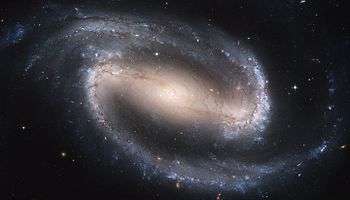Corotation circle
The corotation circle is the circle around the galactic center of a spiral galaxy, where the stars move at the same speed as the spiral arms. The radius of this circle is called the corotation radius. Inside the circle the stars move faster and outside they move slower than the spiral arms.
The Sun is located near the corotation circle of the Milky Way.[1]

Implication with dark matter
The corotation circle takes on particular importance in reference to dark matter.
In barred spiral galaxies (our Milky Way could be a galaxy of this type according to the most recent studies), the stars arranged along the bar structures rotate faster than those arranged along the arm structures, due to gravitational attraction.
It has been calculated that if the radius of corotation were placed at a distance from the center of the galaxy greater than 1.4 times the length of the bar, this would constitute evidence that the rotation of the galaxy is curbed by dark matter halos[2], which are supposed to permeate space around the galaxy.
All the measurements made, where galaxies have made it possible, have so far placed the circles of corotation at distances of less than 1.4, which would lead to the conclusion that dark matter does not significantly influence galactic rotation.
However, a study published in the Astrophysical Journal (ApJ) conducted by researchers from the Instituto de Astrofísica de Canarias has shown that the arms of galaxies rotate more slowly than previously thought, implying that dark matter can influence the rotation of a galaxy even when the corotation circle is placed at a distance less than the value of 1.4 mentioned above[3][4].
References
- Mishurov, Yu. N.; Zenin, I. A. (1999). "Yes, the Sun is located near the corotation circle". Astronomy and Astrophysics. 341: 81–85. Bibcode:1999A&A...341...81M. CiteSeerX 10.1.1.389.1593.
- Debattista, Victor P.; Sellwood, J. A. (2000). "Constraints from dynamical friction on the dark matter content of barred galaxies". The Astrophysical Journal. 543 (2): 704. doi:10.1086/311118.
- Ruscica, Corrado (2017-02-10). "Ecco come frenano le spirali barrate". MEDIA INAF (in Italian). Retrieved 2020-01-01.
- Font, J.; Beckman, J. E.; Martínez-Valpuesta, I.; Borlaff, A. S.; James, P. A.; Díaz-García, S.; García-Lorenzo, B.; Camps-Fariña, A.; Gutiérrez, L.; Amram, P. (2017-02-02). "Kinematic Clues to Bar Evolution for Galaxies in the Local Universe: Why the Fastest Rotating Bars are Rotating Most Slowly". The Astrophysical Journal. 835 (2): 279. arXiv:1702.01743. Bibcode:2017ApJ...835..279F. doi:10.3847/1538-4357/835/2/279. ISSN 1538-4357.